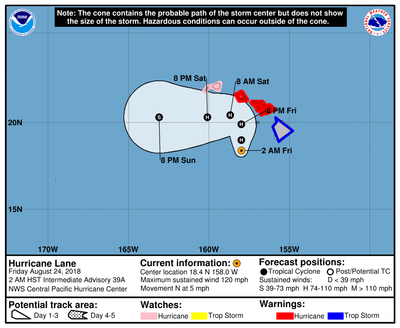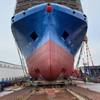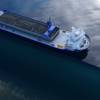Torrential Rain, Howling Winds as Hurricane Lane Nears Hawaii
Hurricane Lane, a powerful Category 3 storm, spun slowly north out of the Pacific toward Hawaii on Friday, causing torrential downpours and catastrophic flooding on the Big Island.
The greatest threat from wind and rain shifted to Maui overnight and then to Oahu, the U.S. state's most populous island, through Friday, the National Weather Service said. Hurricane conditions were possible over Kauai into Saturday, according to forecasts.
More than 2 feet (60 cm) of rain had already fallen on a few areas on the windward side of the Big Island, the weather service said, and peak gusts of up to 67 miles (108 km) per hour were recorded there.
"There's lots and lots of rain, torrential rain, with a lot of moisture in the atmosphere," weather service meteorologist Chevy Chevalier said early on Friday. "We're in it now."
There were no reports of injuries on the Hawaiian Islands, but flash floods and landslides closed some roads.
"Life threatening flash floods. This is a very dangerous situation. Avoid unnecessary travel," Hawaii Governor David Ige warned on Twitter.
While Lane has been downgraded to Category 3 on the five-step Saffir-Simpson scale, but out at sea it still packed maximum sustained winds of 120 mph (195 kph), the service said in an advisory early on Friday.
As of 2 a.m. Hawaii time (8 a.m. EDT/1200 GMT), Lane was moving north at 5 mph (8 kph) and was about 200 miles (320 km) south of Honolulu, the service said. It was forecast to turn west on Saturday, lose some of its punch but move more quickly.
Evacuations were underway on parts of Molokai and Maui islands, and some social media users reported power outages.
On the island of Maui, tourists were advised to avoid a popular attraction called the Seven Sacred Pools, a scenic cluster of waterfalls and grottos.
The latest predictions from the weather service's National Hurricane Center showed the eye of the storm glancing past Maui and several other islands later on Friday on its way to Oahu. But authorities warned the islands could still expect to be hit hard.
"We're telling everybody to take the storm seriously, make your final preparations, and be prepared to ride out what is going to be a prolonged rain event," said Andrew Pereira, communications director for the city and county of the state capital, Honolulu.
In Maui, video footage showed whipping palm trees and darkening skies.
In Honolulu's Manoa Valley neighborhood, sidewalks typically full of joggers and dog walkers were empty late on Thursday as residents stood outside their homes watching the skies, and businesses closed early for the day.
In addition to "life-threatening and damaging surf," the weather service has warned that storm surges could raise water levels 3 to 5 feet (1 to 1.5 metres) above normal along the western shores of the Big Island and that extreme rainfall could mean numerous evacuations and rescues.
Governor Ige has urged residents to set aside a 14-day supply of water, food and medicine. All public schools, University of Hawaii campuses and nonessential government offices on the islands of Oahu and Kauai were closed at least through Friday.
Oil company Par Pacific Holdings Inc said it had shut its 93,500 barrel-per-day refinery in Kapolei due to the storm.
The Coast Guard had ordered all harbors to close to incoming vessels and the Navy moved most of its fleet out of Pearl Harbor, where ships could provide aid after the storm.
In the event of outages, Hawaii's power company, Hawaiian Electric Co, will largely be in charge of restoring power, Federal Emergency Management Agency (FEMA) Administrator Brock Long told reporters on Friday, adding that the company is well prepared to fix any problems to the energy grid.
The federal government will have the responsibility of facilitating "mutual aid agreements," he said, including jobs like getting equipment and teams from the continental United States to locations where they are needed.
"They're called disasters because stuff is broken after the fact, Long said. "And citizens need to realize we're looking at major hurricane impacts.
"And we need to set the expectations that the power could go off for quite some time, and the infrastructure's going to be heavily impacted."
Reporting by Jolyn Rosa; additional reporting by Brendan O'Brien in Milwaukee and Makini Brice in Washington; writing by Daniel Wallis; editing by Jonathan Oatis










